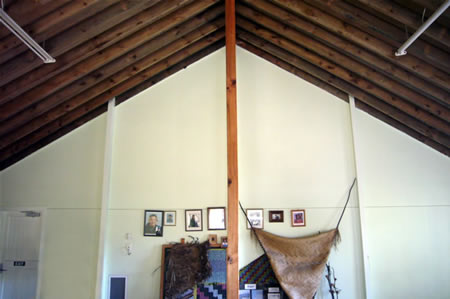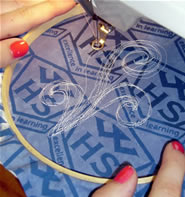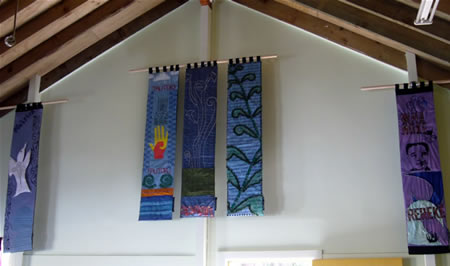Delivery
Developing a brief
The programme of learning started with a visit to Taraika. It gave new students a more in-depth look at the wharenui and provided an opportunity for others to observe it in a new context.
They discussed the opportunities and practicalities in hanging panels, and sketched ideas for installing the panels. One constraint was that they couldn't be placed on the back wall which is reserved for photographs commemorating those who died while attending or working at Wellington High.
They also had to think about any other possible constraints imposed by cultural considerations while discussing how they might approach their brief. Kylie says she directed the class to work out their own solutions, rather than imposing hers, and that their brainstorming sessions resulted in some interesting ideas.
The students agreed that a common theme would unify the individual panels and decided to incorporate the school tikanga using words from it on each panel to make them learning tools as well as decoration. They researched the meaning and background of the tikanga and chose key words for the panels.
Each student was randomly allocated a word. The girls linked the tikanga to their school environment and its location in Mt Cook, overlooking the city, and spent a lot of time thinking about how they would integrate everything into their designs.They walked around the area, sketching or taking photographs, and interviewed teachers and fellow students about their viewpoint and the values they associated with the school.
It proved too difficult to meet with non-school users of the wharenui, so students acknowledged their role but didn't consult them.

The wharenui before the installation of the panels.
Iterative brief development with stakeholders
The class discussed their brief with Matua Ben. He suggested some ideas and pointed out that Taraika is for everyone involved with the school, so that representing different cultures within the Māori context was acceptable.
Planning for practice – cultural implications

Sewing panel.
The students researched traditional Māori crafts, particularly the tukutuku (panel weaving) and kōwhaiwhai (rafter paintings) commonly seen in wharenui, as well as contemporary Māori art. They also looked at the commercialisation of Māori culture and its artistic use by non Māori, both within New Zealand and internationally. This led on to a discussion about intellectual property and how this might apply to traditional indigenous art. The class visited the Museum of New Zealand Te Papa Tongarewa marae and wharenui to observe the decoration, and sketched particular features or made rubbings of patterns which might be suitable to adapt and use in the panels.
Stakeholder consultation
Stakeholder consultation was an important part of the design process. The students made up a survey asking for feedback from some of their other key stakeholders – the principal and deputy principals, and teachers who were Māori or had strong links. They also met with wider stakeholders – kapa haka students, general teaching staff, auxiliary staff and fellow students, to discuss their ideas.
Modelling techniques to use in the panel creation
During this time the class practised a variety of fabric manipulation techniques which they might choose to use in their work. This included a variety of pleating, weaving and gathering methods, freehand stitch sketching, fabric painting, screen-printing, cross-stitching, appliqué, and Kylie demonstrated photographic screen-printing. Students used some of these techniques in their panels and included other skills they had learnt at school or home, such as knotting or plaiting styles.
Each student was given plain calico and allocated $15 when it became too difficult to work within, but students still had to plan carefully and sometimes compromise, one student, for example, could only use a few dye colours rather than the assortment she would have preferred.
As the students designed their panels they had to think about how they might represent their theme, and what techniques they could use to do this, such as representing waves by pleating blue fabric. They trialled different sections before beginning construction of the panel, to ensure that features worked and fitted as planned, and to allow for any changes if something wasn't right or didn't look as effective as imagined.
Evaluating outcomes
After completing their trialling and selecting their final designs, the class started to make their pattern pieces. They also carried out techniques like dyeing fabric and hooking wool. They presented their designs to a meeting of eight teachers and received positive feedback but, as in the real world, controversy did arise.
One participant questioned the placement of the Māori word on the panel, suggesting that its location below the English version implied an inferior status. During a heated discussion the teachers decided that given the wharenui context, the tikanga words should be in Māori.
The students explained how their positioning would have the Māori word at eye level, and why they thought it should be in English as well. They agreed to call the principal and deputy principal into class to adjudicate and, after listening to an explanation as to why the wording should be in Māori, understood the reasoning. This was a good learning experience for the students in terms of realising that although a technologist might be fully involved in creating something, it is the client who makes final decisions.
Once this issue was solved, work progressed relatively smoothly from there, with individual students making any adjustments their design required during construction.

The wharenui after installation of the panels.

The wharenui after installation of the panels.
